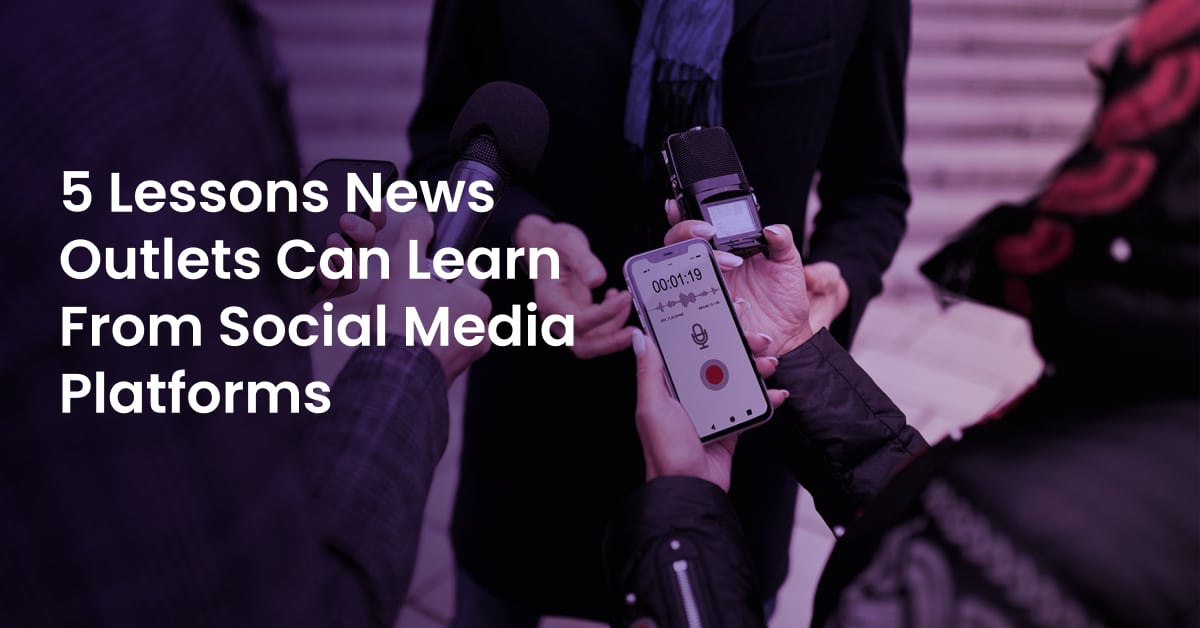


For years, news organizations have struggled in the cold war with social media. Initally, classified revenue plummeted thanks to the rise of Craigslist, then, Google, Facebook, and Amazon stepped in, pulling billions of dollars in advertising revenue that used to be owned by traditional publishing. Today, a handful of mega-companies have successfully built global audiences around content: social media platforms.
To survive and thrive in the 2020s, news organizations need to study and model the specific tactics and strategies of the social media giants. Given that many social media platforms have been knocked down from their high-ground recently, the timing has never been better to take action.
Lesson 1: Offer A Highly Personalized Content Experience To Grow Engagement
Customized news feeds and streams lie at the heart of successful social media. Facebook gives you news updates on friends and family. Twitter, YouTube, Instagram, TikTok, and other platforms offer a curated experience focused on individual users’ interests. Developing this highly curated experience requires the contribution of many engineers, algorithms, and countless experiments.

Applying this lesson to the news organization starts by offering filters. Some of your audience might only want business news, while others simply want coverage of their favorite sports team. Rather than forcing all users to flip through all of your news content, let them choose their interests. In addition, offering subject-specific email newsletters focused on different news interests (e.g., sports, business, local news) will help to deepen audience engagement.
Building detailed profiles of your audience’s likes and dislikes is vital for boosting engagement. Another benefit to offering a customized experience is that you will have better first-party data on your audience. Consequently, you will be able to market your subscriptions more effectively. Also, you will have the opportunity to offer more targeted advertising options to your advertisers.
Lesson 2: Adapt To Changing Media Consumption Habits
Consuming social media content and updates is addictive for a reason. These platforms offer the potential for social validation and a constant stream of novelty. That’s not all – many users are turning to social media to access news content.
Consumption of news is a primary driver of social media.

According to Deloitte’s 2022 digital media trends research, the top five reasons US consumers use social media include reading or watching the news (27%), listening to music (28%, watching TV shows and movies (23%), shopping (17%), play video games (22%) and watch sports (13%). These findings tell us that there is considerable appetite for news. Deloitte points out that the popularity of news consumption on social media is driven by algorithmic customization and cost (i.e., no paid subscription needed).
User-Generated Content Is Gaining In Popularity
Above and beyond news consumption, many social media users are interested in user-generated content. It’s important to note that user-generated content is a broad term that covers professional-grade content creators with high production values, hobbyists, and much more. Deloitte’s research found that 70% of Gen Z now regularly consume user-generated content – a figure that has rapidly increased over the past year.
Short-Form Video Content Is Booming
Short video content, typically less than a minute long, is thriving. The most popular content creators on TikTok, like Khabane Lame, Charli d’amelio, and Addison, have uploaded over 1,000 videos to build their audience. Many successful short videos feature videos, dancing, and humor.

Adapting To New Media Consumption Habits
Adapting to these habits as a news organization is challenging. Traditionally, news organizations focus on high production values and professionalism, which isn’t always found in user-generated content. Despite that challenge, there are opportunities to respond to this challenge. Take video content as an example. Your organization likely has significant strengths in video production and editing. Use those capabilities to create content like TikTok videos and YouTube shorts like the Washington Post.
Lesson 3: Emphasize Individuals In Addition To Your Corporate Brand
Many, if not most, social media success stories involve individuals. Take MrBeast (i.e., Jimmy Donaldson) on YouTube. With more than 100 million subscribers, he has built one of the most successful channels on the platform. Many other top channels on the platform are built around individuals like Eminem, Justin Bieber, and Swedish YouTube star PewDiePie.
Applying this lesson in a new organization is relatively easy. For the past decade, many successful journalists like Maggie Haverman (New York Times), Rachel Maddow (MSNBC), and Anderson Cooper (CNN) have built a large following on Twitter. The opportunity to interact directly with your journalists is crucial. Fundamentally, engaging with a specific person is easier than with a brand.
Building an audience around a personal brand is easier for several reasons. Forming a parasocial relationship where an audience member feels connected to the content creator is easier. Social media personalities sometimes deepen these relationships by adding exclusive experiences to paying customers using platforms like Patreon.
There are a few ways to apply this social media lesson to your news organization. Look at all of your public-facing journalists and personalities and their online profiles. Find out who successfully engages with their followers by looking at replies, likes, and comments. Invite your most successful journalists to present their best practices to others in the organization.
Lesson 4: Encourage Niche Communities
Social media platforms are excellent at bringing together small groups of people with shared interests. For example, there are online groups for people interested in obvious things like real estate investing, auto repair & fashion and each of these larger audience can be further cut into niche segments.
Let’s take sports as an example. Spending five or ten minutes searching through Facebook you can easily find groups like:
- Obsessed with NCAA Wrestling Updates (9,000+ members)
- NBA Fantasy Basketball Discussion (11,000+ members)
- Mets Fans For Life (18,000 members)
- Yankees Fans (100,000+ fans)
These examples show an audience like “sports fans” has multiple significant segments. News organizations with deep connections in local sports teams have an opportunity to shine by creating dedicated niche communities. Getting started is easier than you might imagine because news organizations already have high-quality content to build their communities on.
Lesson 5: Embrace Technical Innovation
Move fast and break things is a well-known saying in the technology industry. Social media platforms often launch new features as they observe their users and advertisers. For example, Instagram has recently focused on video content to compete more effectively against TikTok.
News organizations may not have the same kind of product development, engineering, and technical bench strength as social media companies. Fortunately, this is less of a disadvantage than you might think. The rise of no-code and low-code platforms and integrations means adding new technologies to your website is easier than ever.
Want to improve your coverage and engagement of rapidly developing news stories like international conflicts and elections? You can install Arena Live Blog on your website in a few minutes. Want to build online events like the Wall St Journal’s Live Q&A Events? Add Arena Live Chat to your website to supplement the video streaming experience so your audience can share their feedback and questions.
Don’t Ignore Your Greatest Strength As You Innovate
There’s no doubt that news publishers can draw lessons from social media platforms. Yet, there’s a danger in drawing too much inspiration from these platforms. You don’t want to lose the soul of your organization as you chase growth.
The most trusted news organizations have built audiences for decades. Social media companies don’t invest in investigative journalism. News organizations hold elected officials accountable for their actions and words. The best news organizations focus on fact-checking and admitting mistakes. In contrast, social media platforms have a much less impressive track record of quality and accountability.
Investigation, fact-checking, and taking on powerful interests carry a cost. Yet, those commitments are ultimately critical for maintaining your reputation and keeping engaged subscribers. If your audience loses trust in your organization, selling subscriptions and advertising space will become more difficult.
The good news is that you can innovate without selling your soul as a news organization. The first step is to add the right technology to your website. These technologies don’t require weeks or months of customization and implementation either. You can be up and running in a matter of hours when you choose Arena.
Transform The News Into An Interactive Community Experience
Publishing high-quality news, analysis, and information are no longer enough to sustain news organizations. Your website needs to offer an online community to win attention and engagement from social media platforms. Your audience wants to ask questions, meet people who share their interests, and more. Right now, social media offers these community experiences. Yet social media lacks the commitment to investigation, reporting, and truth that leading news organizations have.
Give your audience a chance to interact with each other, and engagement will go up. Page views and time on site will also increase. Book a demo with Arena today to discover how to engage your audience more.



